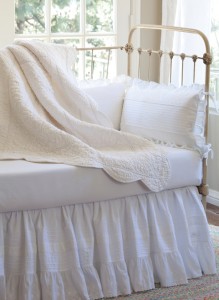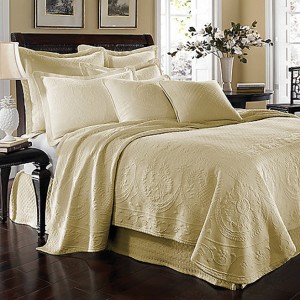Summery Coverlets: The Textures and Timeless Beauty of Quilts and Matelassé

 As the weather heats up, it feels so refreshing to lighten our dress—not just on ourselves, but also inside our homes! It’s time to pack away the wool blankets and down comforters in favor of breezy, lightweight bedding. Nothing says “summer” quite like a cheerful coverlet on a bed made with crisp, cotton sheets.
As the weather heats up, it feels so refreshing to lighten our dress—not just on ourselves, but also inside our homes! It’s time to pack away the wool blankets and down comforters in favor of breezy, lightweight bedding. Nothing says “summer” quite like a cheerful coverlet on a bed made with crisp, cotton sheets.
Coverlets—lightweight quilted bedspreads—are intended for use as the top layer of linens on a bed. They can be decorative and warming, used alone, or with a top sheet and a light blanket. They can also be layered at the foot of the bed, simply for decorative purposes. But why relegate them to the bedroom? They can add color and texture to your home in a number of ways.
Dream in Color with a Patchwork Quilt
If you’ve never thought that a quilt could be a part of your modern décor—think again! Their bold patterns are clean and confident, certain to infuse your home with a unique character. Quilts that feature geometric patterns especially seem inspired by modern art.
Quilts have a special way of conjuring feelings and memories of family, history, tradition and simple beauty—whether they are an heirloom antique, recently made using a computerized sewing machine, or store-bought new. Whatever its origin, when you look at a quilt, it’s hard not to imagine a group of women spending many meticulous hours working together to complete it—perhaps for a special life event like a marriage or a birth. Or maybe because they were expressing themselves through the only art form they knew—creating a mosaic out of fabrics that held special memories for them.
 Quilts are traditionally composed of three layers of material: an insulating layer of batting sandwiched between the decorative woven top and the backing material. Patchwork quilts are unique from other bed covers because their decorative top layer is “pieced together” from many swatches of cloth and sewn into geometric designs or fanciful patterns. (Originally, this was a practical “waste not, want not” homesteader’s aesthetic of making full use of leftover scraps of fabric.) The fabric used for the backing is usually a different color or pattern than what’s found on the topside of the quilt, so when the bed covers are invitingly folded back over the foot of the bed, glimpses of the contrasting fabrics can be shown.
Quilts are traditionally composed of three layers of material: an insulating layer of batting sandwiched between the decorative woven top and the backing material. Patchwork quilts are unique from other bed covers because their decorative top layer is “pieced together” from many swatches of cloth and sewn into geometric designs or fanciful patterns. (Originally, this was a practical “waste not, want not” homesteader’s aesthetic of making full use of leftover scraps of fabric.) The fabric used for the backing is usually a different color or pattern than what’s found on the topside of the quilt, so when the bed covers are invitingly folded back over the foot of the bed, glimpses of the contrasting fabrics can be shown.
Quilts are certainly works of art, so it makes sense that you could refashion them to be displayed on a wall. As with any other kind of displayed artwork, be mindful of where you’ll be hanging your quilt, as sunlight beaming through a nearby window will certainly fade its colorful palette and potentially damage the fibers in the fabric. Choose a spot that receives filtered or indirect sunlight, if not a place that is completely away from the sun’s rays.
Quilts can be hung from special rods or clamps designed especially for the purpose. To display a quilt from a rod, you’ll need to sew tabs or loops onto the back of the quilt so you can slip the rod through. The quilt will hang from the rod, giving a homespun twist to the medieval tapestry wall hanging. Or consider kicking the style up a notch, and use an ultra-mod rod for an interesting juxtaposition of old and new. An acrylic rod or one in a contemporary square shape in a bright color could add an element of fun to the display!
 Also playing on this idea, you could position a quilt to drape behind your bed as a “headboard” by attaching a pair of brackets and a drapery rod to the wall then draping the quilt over the rod. What a cool twist for a contemporary Japanese- or mid-century-modern style platform bed!
Also playing on this idea, you could position a quilt to drape behind your bed as a “headboard” by attaching a pair of brackets and a drapery rod to the wall then draping the quilt over the rod. What a cool twist for a contemporary Japanese- or mid-century-modern style platform bed!
Quilt clamps safely pinch the top edge of the quilt in a cushioned clamp that won’t damage the quilt as it suspends from the padded hanger. The benefit to displaying your quilt in this manner is twofold: you can easily remove it for cleaning, and no special tabs/loops have to be attached to the back of the quilt, possibly altering or damaging its original handicraft. If you’re a collector of quilts, quilt clamps make it easy to change your display for this same reason.
A sleek, contemporary look for displaying quilts on the wall is to have them framed under glass and hang them just as you would any other framed picture. Due to size, framing just a portion of a quilt (or several different ones, hung in a grouping) is a practical choice, although there’s no question that a full-sized wall hanging of an entire quilt would be a dramatic accent if you wanted to add a strong jolt of color and pattern to a room. The interplay between a contemporary-styled frame and an antique handmade quilt would add loads of interest and become a focal point in your home.
 One very common out-of-bedroom use for quilts is to tuck them onto a sofa or armchair, to help protect it (similar to a slipcover). Toss pillows can also be made from quilt fragments as a delightful way to display multiple patterns and colors. This is a great way to salvage a portion of a quilt that may have suffered stains or damage.
One very common out-of-bedroom use for quilts is to tuck them onto a sofa or armchair, to help protect it (similar to a slipcover). Toss pillows can also be made from quilt fragments as a delightful way to display multiple patterns and colors. This is a great way to salvage a portion of a quilt that may have suffered stains or damage.
Using a quilt as a tablecloth is a lovely way to display it, allowing you to trace the stitches with your fingertip and admire it up close. Many newer quilts are machine washable, which alleviates much of the worry about spills. But if it is a vintage quilt, have a glass top cut to fit your table to help protect it.
Quiet Time with Serene Matelassé
Similar to quilts, matelassé coverlets are made from cotton but woven on a Jacquard loom, which results in a coverlet with a raised pattern upon it. This special style of weaving is thought to have been developed by an Englishman named Robert Elsden to mimic the style of handcrafted quilts made in the south of France. In fact, Elsden was honored by the Society for the Encouragement of Arts, Manufactures and Commerce in 1745 for his textile innovation!
 Matelassé coverlets are lighter-weight than most quilts, as they are made from just a single layer of fabric. Matelassé are usually in monochromatic tones—white thread stitched onto white fabric, or ivory-on-ivory—and they depend on their texture for design.
Matelassé coverlets are lighter-weight than most quilts, as they are made from just a single layer of fabric. Matelassé are usually in monochromatic tones—white thread stitched onto white fabric, or ivory-on-ivory—and they depend on their texture for design.
Thanks to the simple textures on a neutral background, matelassé exude purity and refinement but also can make a crisp, contemporary statement, too. Of course, you could substitute a matelassé and display them in your home in any of the ways you would a quilt. Of course, they are terrific on a bed, but they also look great tucked onto the couch—especially if you want to lighten up your living room’s color palette for summer. You’ll need to check the care and cleaning instructions for your coverlet, of course, but many can be machine-washed (some, even bleached!), so they can be a particularly resilient choice for use as a slipcover.
A few other places where matelassé look especially fresh are at the bedside, when used as a skirt on a round table or as shams on the bed, or even hung as a shower curtain in the bathroom. Matelassé look so cool and clean, even if at their heart they’re simply a humble bedcovering. It’s no wonder they call them “shabby-chic.”
Quilts and matelassé coverlets can give your home so much character. Showcase your sentimental side by displaying a quilt in an unexpected way this summer. Summer is the perfect time to get your quilts out of the hope chest and into your home décor!
Bedspreads, Coverlets, Display Quilts, Lightweight Bedding, Matelassé, Quilt Tablecloth, Quilts






